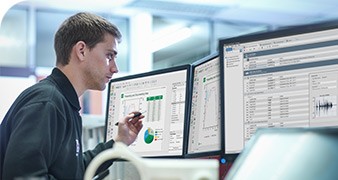Developing Embedded Applications Using CompactRIO and LabVIEW Real-Time Course Overview
Developing Embedded Applications using CompactRIO and LabVIEW Real-Time course delivers a learning experience for designing, prototyping, and deploying a reliable Real-Time application using NI compactRIO. At the end of the course, you will be able to translate your embedded system requirements into a scalable software architecture, choose appropriate methods for inter-process and network-based communication, design, deploy and define your Real-Time datalogging, control, and/or monitoring algorithm.
Available Formats
Course Objectives
-
Design, prototype, and deploy a datalogging control & monitoring application
-
Acquire and generate analog and digital signals, control timing, and implement signal processing on RT
-
Implement additional functionality on the RT target for logging, network communication, system health monitoring, and reliability using the LabVIEW Real-Time Module
-
Implement a human machine interface (HMI) on the PC
-
Communicate data between FPGA, RT, and PC
-
Debug, benchmark, and test your application
-
Deploy your application to multiple systems
Course Details
Duration
-
Instructor-led Classroom: Four (4) days
-
Instructor-led Virtual: Five (5) days, six-hour sessions
Audience
-
Users preparing to develop embedded control and monitoring applications using LabVIEW Real-Time and LabVIEW FPGA with CompactRIO, Single-Board RIO, and Real-Time PXI hardware
-
Users interested in learning about performance and reliability considerations using NI Real-Time and FPGA targets
Prerequisites
-
LabVIEW Core 1 and LabVIEW Core 2
NI Products Used
-
LabVIEW Professional Development System
-
LabVIEW FPGA Module
-
LabVIEW Real-Time Module
-
NI CompactRIO Controller
-
NI Analog Input, Analog Output, Thermocouple Input, and Digital Output modules
Training Materials
-
Virtual instructor-led training includes digital course material that is delivered through the NI Learning Center
-
NI virtual instructor-led training is delivered through Zoom, and Amazon AppStream/LogMein access is provided to participants to perform the exercises on virtual machines equipped with the latest software
Cost in Credits
-
Public virtual or classroom course: 40 Education Services Credits or 12 Training Credits
-
Private virtual or classroom: 280 Education Services Credits or 80 Training Credits
Developing Embedded Applications Using CompactRIO and LabVIEW Real-Time Course Outline
| Lesson | Overview | Topics |
|---|---|---|
Introduction to Embedded Measurement, Control, and Monitoring Using LabVIEW Real-Time | Explore an embedded application requiring data logging, control, and monitoring capabilities. |
|
Identifying Application Requirements | Explore the considerations when designing and developing an embedded application. |
|
Document Your Design | Explore the use of diagrams to aid in system design. Implement the design for the CompactRIO-based course project. |
|
Configure Your Hardware | Set up real-time HW and install the necessary SW to work with the CompactRIO. |
|
Accessing Your I/O in LabVIEW | Explore the methods available to use the I/O channels of your hardware. |
|
Programming Using LabVIEW Real-Time | Learn how to access the inputs and outputs of your RT target in your application. |
|
Inter-Process Communication in LabVIEW Real-Time | Learn how to transfer data between multiple loops on your Real-Time VI. |
|
Communicating between the Real-Time Target and Host PC | Explore how to transfer data and communicate between a host PC and an RT Target. |
|
Managing Memory and Monitoring System Health | Explore best practices for monitoring RT system health, memory, and CPU usage to mitigate potential issues during application execution. |
|
Creating Reliable RT Applications | Learn about the techniques available to improve the reliability of your RT system and application |
|
Debugging, Benchmarking, and Testing | Explore methods for debugging, benchmarking, and testing your real-time application. |
|
Deployment and Replication | Deploy a stand-alone RT application and replicate it on multiple RT targets. |
|
Continue Your Learning Path
Developing Embedded Applications using CompactRIO and LabVIEW FPGA
Developing Embedded Applications using CompactRIO and LabVIEW FPGA course delivers a learning experience for designing, prototyping, and deploying reliable FPGA code for application using NI CompactRIO.
SystemLink Server to Manage Systems and Data
This course teaches how to use the SystemLink server environment to manage test systems, deploy software, manage hardware assets, and collect and analyze test results.
Exploring Data Interactively Using DIAdem
Exploring Data Interactively Using DIAdem teaches importing data sets, analyzing them visually and computationally, and creating publisher-quality reports. Learn how to use DIAdem SCRIPT to automate each of these tasks.
Upgrade to Membership
If you are planning to take three or more NI instructor-led courses within one year, a Training Membership provides cost-effective, unlimited access to all NI public classroom and public virtual courses, along with unlimited certification vouchers.


